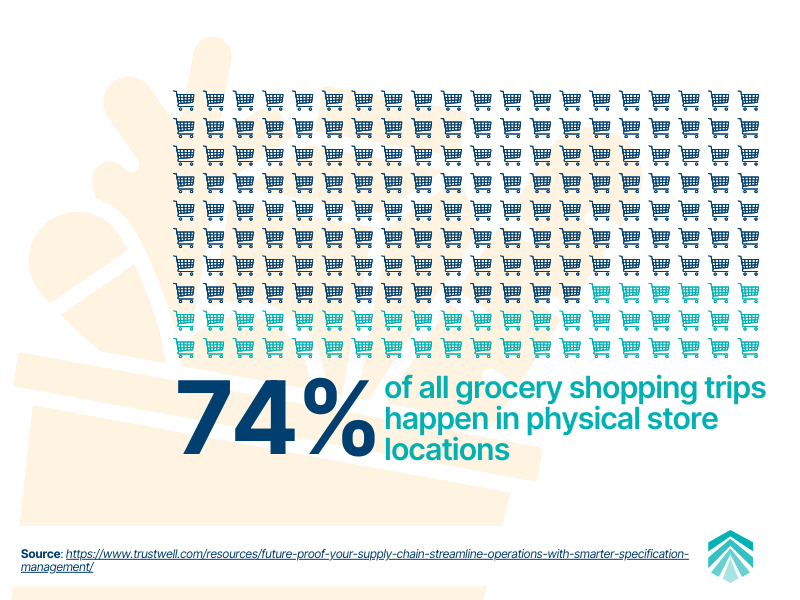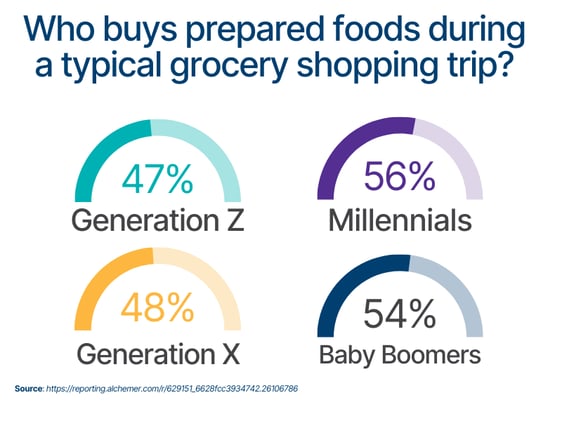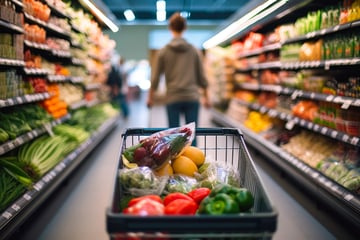The line between grocery stores and restaurants have blurred. Today’s consumers expect more than just a place to shop for ingredients; they want a complete dining experience with fresh, high-quality meals ready to eat. Enter the grocerant. A portmanteau of grocery and restaurant, the concept emerged as a trend in the early 2010s and has grown into a mainstream dining concept in the years post-pandemic.

From chef-driven prepared meals to full-service seating areas, grocery stores cater to busy consumers who want fresh, healthy, and convenient meal solutions without breaking their monthly budget. With 74% of grocery shopping trips taking place in physical stores each month, according to a 2024 survey distributed by Drive Research, and as consumers increasingly seek out convenience, dine-in or grab-and-go options at grocery stores have become increasingly popular for grocers and shoppers alike.
During the pandemic, retail food service purchases dipped, but now they're on the rise again; a 2022 study released by PYMNTS showed that 37% of grocery shoppers had purchased prepared foods during a shopping trip in July of that year, up from 30% the previous November.
At the same time, the rapid growth of food transparency regulations and supply chain technology is reshaping how grocers approach food safety, traceability, and consumer trust. With new tools and strategies, retailers can now provide the same level of confidence and accountability that restaurants are expected to maintain.
So, what’s next for the grocerant? Let’s explore the latest industry trends, consumer preferences, and the essential role of food safety technology in shaping the future of grocery dining.
The Changing Consumer: What Today’s Grocery Shoppers Want
Today’s grocery shoppers are looking for fast, affordable, and high-quality meal solutions—and grocerants are delivering. While Millennials once drove this shift, Gen Z and busy professionals of all ages are now fueling demand for restaurant-quality meals at grocery store prices.
Convenience is the top priority.
Consumers want ready-to-eat meals that fit into their schedules, whether that means grabbing a hot meal on their lunch break, picking up dinner on the way home, or ordering through a grocery delivery app. Many grocers are expanding their grab-and-go selections, pre-packaged meal kits, and heat-and-eat options to meet this demand.
Read More: How Trustwell’s Quality Management Solution Helped Whole Foods Market Improve Food Safety Audit Scores
Price is another major factor. Eating out is expensive; many consumers seek ways to cut costs without sacrificing quality. Grocerants offer an appealing alternative: fresh, chef-prepared meals at a fraction of restaurant prices. With reduced overhead costs compared to traditional restaurants, grocery stores can provide a cost-effective dining solution that keeps customers coming back.

Technology is also making grocery dining more accessible. Mobile apps, digital kiosks, and online ordering allow customers to customize their meals, schedule pickups and even use grocery store loyalty rewards to save money on prepared foods. Some grocers are also partnering with third-party delivery services to bring fresh, hot meals straight to customers’ doors—further blurring the line between grocery stores and restaurants.
Listen Up: The Future of Restaurant Delivery with Meredith Sandland
Ultimately, today’s grocery shoppers want fast, affordable, and high-quality dining options that fit seamlessly into their busy lives. Grocerants that focus on efficiency, competitive pricing, and digital convenience will be best positioned to meet this growing demand.
How Grocers Can Elevate the In-Store Dining Experience
As grocery stores become dining destinations, grocers can create elevated food service experiences rivaling fast-casual and fine-dining establishments to compete with traditional restaurant spaces.
A key strategy is the expansion of chef-driven menus. Instead of (or in addition to) standard hot bars and salad stations, grocers offer restaurant-quality meals prepared by trained chefs. Stores like Whole Foods, Wegmans, and Hy-Vee have developed gourmet meal stations featuring wood-fired pizzas, sushi counters, build-your-own bowls, and fresh seafood bars. This shift transforms the grocery store into a place where customers don’t just shop—they stay and enjoy a meal.
Read More: How Wegmans Food Markets Streamlined Nutrition Information with Genesis Foods
Another major upgrade is cafe-style seating areas designed to encourage social dining. Many grocers now provide comfortable seating, free Wi-Fi, and even live music or happy hour specials to create a more engaging atmosphere. These spaces make grocery dining more inviting, positioning stores as community hubs rather than transactional retail spaces.
Technology can also play a big role in improving the dining experience. Self-order kiosks, QR-code menus, and mobile checkout options make the process fast and frictionless. Some grocers have even partnered with food delivery services to expand their prepared meal reach beyond the store, offering local delivery for customers who want the quality of a grocerant meal without the trip. By investing in better food, more inviting dining spaces, and digital convenience, grocers are proving that they can offer a top-tier dining experience alongside their traditional retail offerings.
The Role of Food Safety & Transparency in Retail Foodservice
As grocerants continue to grow, so does the need for food safety and supply chain transparency. Consumers now expect detailed information about where their food comes from, how it’s prepared, and whether it meets the highest safety standards. For grocers, this means adopting advanced food traceability systems and compliance technology.
One of the biggest challenges for grocerants will be managing a complex supply chain. Fresh ingredients move through multiple suppliers, making real-time tracking essential to ensure quality and prevent contamination. The Food Safety Modernization Act (FSMA) 204 has also heightened requirements for traceability in the food supply chain, making compliance a top priority for retailers who want to tap into the increased foot traffic and revenue that grocerant customers can bring.
Read More: What do Restaurants, Retailers, & Distributors Need to Know About FSMA 204
To meet these demands, grocers are looking toward digital traceability solutions that provide a real-time view of their supply chains. These systems allow retailers to:
- Track ingredients from farm to store, ensuring freshness and authenticity
- Monitor supplier compliance to ensure all vendors meet safety regulations
- Provide consumers with detailed product information
- Automate recalls to remove unsafe products from shelves quickly
Food transparency isn’t just about regulations—it’s also a significant factor in earning and keeping consumer trust. Many grocers are adding smart labels, QR codes, and mobile apps that allow shoppers to scan items and see detailed sourcing and nutritional data.
This level of visibility builds confidence, ensuring customers that their food meets high safety and ethical standards. Ultimately, grocers prioritizing food safety, compliance, and transparency will meet regulations and strengthen customer loyalty in an increasingly competitive market.
Looking Ahead: The Future of the Grocerant
The grocerant is here to stay, but what’s next? Innovation in food service, technology, and sustainability will continue shaping the future of in-store dining.
One central area of growth is AI-powered personalization. Imagine a grocery store that recommends customized meal options based on your past purchases, dietary preferences, and health goals. Some retailers are already experimenting with smart shopping carts, AI-driven meal planning, and dynamic pricing based on customer behavior. Sustainability will also continue to play a role. Consumers are pushing for zero-waste initiatives, reusable packaging programs, and carbon-neutral dining options. In response, many grocers are:
- Reducing food waste by repurposing unsold produce into prepared meals
- Partnering with local farms to ensure fresher, more sustainable sourcing
- Using compostable and reusable packaging to reduce environmental impact
Another growth driver is the integration of prepared foods into e-commerce and delivery services. Grocers are increasingly bundling meal deals with traditional grocery orders, allowing consumers to add a ready-made dinner to their weekly shop. Partnerships with delivery apps like Instacart, DoorDash, and Uber Eats have also made it easier for customers to order hot meals from their local grocery store without setting foot inside while Too Good To Go serves up bargains for shoppers and reduces food waste for retailers.
Tech-Enabled Retail Foodservice Solutions
As market competition heats up, efficiency and consistency will be critical. Shoppers expect fresh, high-quality meals every time, and any misstep—a quality issue, allergen mislabeling, or a slow recall response—can damage customer loyalty and brand reputation. That’s why many grocers are turning to traceability and compliance technology to monitor suppliers, track ingredients, and respond quickly when problems arise.
Ultimately, today’s grocery shoppers want fast, affordable, and high-quality dining options that fit seamlessly into their busy lives. Grocerants focusing on efficiency, competitive pricing, and digital convenience will be best positioned to meet this growing demand. Trustwell’s suite of solutions, including FoodLogiQ Product Management, Traceability, and Recall can help grocers ensure product quality, streamline supplier processes, and respond quickly to safety issues—all while building consumer trust.
Explore how Trustwell can support your prepared foods program and strengthen your supply chain from recipe to recall. Check out our library of resources and thought leadership, schedule a personalized demo, or grab a copy of our Consumer Sentiment Report on Transparency & Recall Response below.








